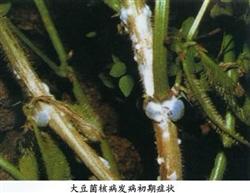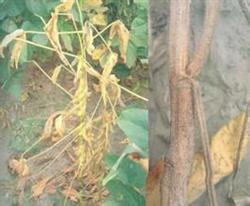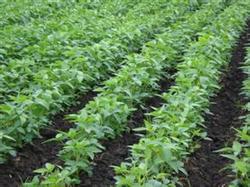Occurrence and control of Sclerotinia sclerotiorum in soybean

Sclerotinia sclerotiorum is a common disease on soybean crops, which mainly causes stem rot, pale lesions, hollow stems and black sclerotia, which is easy to break. In the past two years, soybean Sclerotinia sclerotiorum has a tendency to increase year by year. Causes and characteristics: 1. Sclerotinia sclerotiorum is a fungus with a large number of sclerotia in the field, which forms cylindrical or mouse dung-shaped sclerotia on the soybean stem, its shape is irregular, the size is 1mm × 4mm × 3mm, and the sclerotia germinates under rainy, wet and light conditions. the pathogenic fungi overwintered by sclerotia scattered in the soil and mixed among seeds, and seeds can also carry bacteria. two。 Environmental factors in the flowering stage of soybean, high soil surface temperature, high air humidity and heavy rainfall are conducive to the occurrence of the disease. 3. If the seed sclerotia is used as the seed harvested in the previous year, the sclerotia residue in the seed may be increased and the occurrence of soybean sclerotia disease will be aggravated year by year. 4. The occurrence of Sclerotinia sclerotiorum was serious in the plots with high planting density. The reason is that excessive close planting will cause poor ventilation and excessive humidity, which is conducive to the disease; soybean sclerotinia disease occurs seriously in the plots adjacent to sunflowers and rape; in addition, soybean sclerotinia disease occurs seriously in continuous cropping plots. Prevention and control countermeasures: 1. Reasonable rotation of soybean Sclerotinia sclerotiorum only spreads harm to soybean, sunflower and rape, but does not infect Gramineae crops. Therefore, it is necessary to reform the farming system, implement rotation for more than three years, avoid being adjacent to sunflowers and rape fields, and control the spread of Sclerotinia sclerotiorum. two。 Before sowing selected seeds, the sclerotia mixed in soybean seeds should be screened, and disease-resistant seeds without sclerotia should be selected for sowing. 3. Strengthen cultivation management, reasonable close planting, desilting and waterlogging control, leveling the land, opening ditches and drainage, preventing stagnant water and water transmission, shoveling in time before ridge sealing of soybean, and eliminating germinated sclerotia and ascomycetes. The seriously affected plots of soybeans should be turned deep after harvest, and the diseased remains and sclerotia should be turned into the ground. 4. Chemical control in the flowering stage of soybean, soybean sclerotia just began to germinate and unearthed to the peak stage of the formation of ascomycetes, 1500 times of 50% Sukeling wettable powder was sprayed on the surface of ridge soil, or 1000 times of 50% Nongliling wettable powder was sprayed with 30 kg. The plot sprayed with the above chemicals can control soybean Sclerotinia sclerotiorum by more than 85%.
- Prev

Occurrence and control of soybean blight
Soybean blight is commonly known as "dead tree", "quenching" and "black root disease". In years with serious disease, the rate of plant death in lightly diseased fields was 5% to 10%, and that in seriously diseased fields was more than 30%. Individual fields even died out, resulting in no yield. 1. The symptom of soybean blight in the field occurred only in the seedling stage, and the main roots of seedlings and young plants.
- Next

Control measures of soybean diseases
Sclerotinia sclerotiorum mainly infects soybean stems and usually begins to occur in late July. Brown spots appeared on the stems at the early stage of infection, white cotton flocculent mycelium and white particles appeared on the later spots, and then black particles (sclerotia) appeared. Vertical dissection of diseased plant stems, visible black cylindrical rat-like sclerotia, diseased plant dead after...
Related
- The first cup of black tea in spring, the flavor and history of tea gardens in Kenya, Africa
- The computer can not only choose potatoes, but also grow tea rice. AI will grow winter oolong tea champion.
- It is not only the inflated tea bitten by insects, but also engraved with the four seasons tea in Beipu.
- The Oriental Beauty Tea Festival in Zhuxian County takes the stage at the weekend to experience the plus-size feast of oil tea.
- & quot; Oriental Beauty Tea & Exploration of Emei in Hsinchu, the hometown of quot;
- The new variety of strawberry "Tainong 1" dessert is the first choice with mellow aroma. Crimson gorgeous
- History of Tea in Taiwan: from Wild Inner Mountain to Export Tea Garden
- Two types of Taiwan Oriental Beauty Black Tea won the British three-Star Award for Childhood Tea Xiang Zhang Jiaqi changed from pilot to champion tea maker.
- Banana species and varieties: the planting history of Taiwan Xianren banana and dwarf banana is long, is banana disease resistant?
- Coffee planting Technology: Qianjie Coffee from Seedling to harvesting

